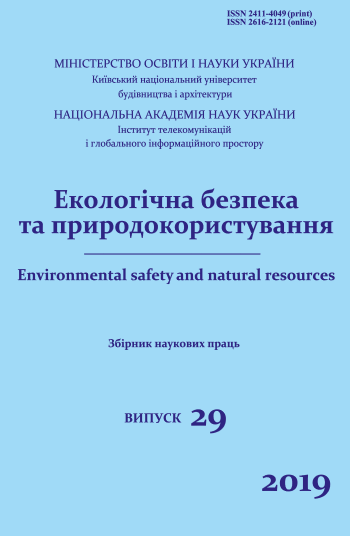Еnsuring the conditions of ecological safety of the surface water of Ukraine by calculating the values of their assimilative capacity
DOI:
https://doi.org/10.32347/2411-4049.2019.1.28-39Keywords:
assimilative capacity, environmental safety, self-cleaning, wastewater, surface water, multiplicity of wastewater dilutionAbstract
The values of discharge of circulating (waste) waters of different quality categories in surface water objects by regions of Ukraine are analyzed. For maintaining the natural equilibrium of aquatic ecosystems the indicators of actual and limit necessary of the multiplicity of dilution of circulating (waste) waters of different quality categories by local river runoff are calculated and analyzed. The values of the limit assimilative capacity of surface water objects, which can accept a certain amount of circulating (waste) waters without violating their ecological stability, is determined. The characteristics of the level of assimilative capacity utilization of local river runoff resources of different degrees of water availability are calculated and given. It has been established that in the years with average water availability the level of use of the assimilative capacity of local river runoff resources of the Nikolaev, Kharkiv and Kherson regions is characterized as “moderate”, and Odessa – as “high”. In the years with a very low river water content, the level of use of the assimilative capacity of surface water bodies in Kiev, Kirovograd, Luhansk, Lviv, Sumy and Cherkasy regions is rated as “moderate”, Mykolaiv and Kharkiv – as “high”, Kherson and Odessa – as “very high”. Regardless of the level of provision with local river runoff, the index of the use of the assimilative capacity of water resources in Zaporizhia, Donetsk, and Dnipropetrovsk regions exceeds the threshold value (IAC = 1) by 10.35–99 times.References
Romanenko, V. D. (2000). Kompleksna ocinka ekologichnogo stanu basejnu Dnipra. Kyiv: IGB NAN Ukrayini (in Ukrainian).
Hilchevskij, V. K. (2009). Vodni resursi ta yakist richkovih vod basejnu Pivdennogo Bugu. Kyiv: Nika-Center (in Ukrainian).
Krajnyukov, O. M. (2015). Suchasnij ekologichnij stan vodnih ob’yektiv basejnu richki Siverskij Donec. Lyudina ta dovkillya. Problemi neoekologiyі, (3-4), 71-77 (in Ukrainian).
Hilchevskij, V. K. (2013). Gidrohimichnij rezhim ta yakist poverhnevih vod basejnu Dnistra na teritoriyi Ukrayini. Kyiv: Nika-Center (in Ukrainian).
Lozovickij, P. S., & Lozovickij, A. P. (2007). Himichnij sklad vodi richok Ukrayinskogo Polissya i ekologichna ocinka yih yakosti. Vodne gospodarstvo Ukrayini, (5), 45-54 (in Ukrainian).
Udod, V. M., & Vildman, I. A. (2014). Naukove obgruntuvannya vikoristannya pokaznikiv asimilyacijnogo potencialu ta asimilyacijnoyi yemnosti dlya ekologichnoyi ocinki stanu gidroekosistem richok. Ekologichna bezpeka, 1(17), 50-53 (in Ukrainian).
Cependa, M. M. (2012). Gospodarska osvoyenist asimilyacijnogo potencialu richok basejnu Serednogo Dnistra. Naukovij visnik Volinskogo nacionalnogo universitetu imeni Lesi Ukrayinki. Geografichni nauki, (18), 28-35 (in Ukrainian).
Cairns, Jr. J. (1999). Assimilative Capacity – the Key to Sustainable Use of the Planet. Journal of Aquatic Ecosystem Stress and Recovery, 6(4), 259-263. doi: 10.1023/A:1009902127556.
Chiejine, C., Igboanugo, A., & Ezemonye, L. (2015). Diverse approaches to modelling the assimilative capacity of a polluted water body. Nigerian Journal Of Technology, 35(1), 196. doi: 10.4314/njt.v35i1.27
Glasoe, S., Steiner, F., Budd, W., & Young, G. (1990). Assimilative Capacity and Water Resource Management: Four Examples from the United States. Landscape and Urban Planning, 19(1), 17-46. doi: 10.1016/0169-2046(90)90033-X.
Hernandez, E., & Uddameri, V. (2013). An Assessment of Optimal Waste Load Allocation and Assimilation Characteristics in the Arroyo Colorado River Watershed, TX along the US-Mexico border. Clean Technologies and Environmental Policy, (15), 617-631. doi: 10.1007/s10098-012-0546-6.
Prokopenko, O. M. (Ed.). (2018). Statistichnij zbirnik «Dovkillya Ukrayini za 2017 rik». Kyiv: Derzhavna sluzhba statistiki Ukrayini (in Ukrainian).
Vishnevskij, V. I., & Kosovec, O. O. (2003). Hydrological characteristics of the rivers of Ukraine. Kyiv: Nika-Center (in Ukrainian).
Koronkevich, N. I. (1990). The water balance of the Russian Plain and its anthropogenic changes. Moscow: Nauka (in Russian).
Downloads
Published
How to Cite
Issue
Section
License
Copyright (c) 2019 Daria V. Kulikova, Anneta A. Yurchenko

This work is licensed under a Creative Commons Attribution 4.0 International License.
The journal «Environmental safety and natural resources» works under Creative Commons Attribution 4.0 International (CC BY 4.0).
The licensing policy is compatible with the overwhelming majority of open access and archiving policies.

